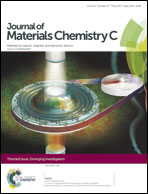Aromatic bi-, tri- and tetracarboxylic acid doped polyaniline nanotubes: effect on morphologies and electrical transport properties†
Abstract
Polyaniline nanotubes have been prepared in a facile manner via the chemical polymerization of aniline in an aqueous medium using ammonium persulphate (APS) and ten different dopant acids. The formation of PANI in the composite was confirmed using 1H-NMR, UV-Vis and FTIR spectroscopic studies. An intensive FESEM investigation indicated that the dopant acid plays an important role in the formation of the PANI nanotubes. In particular, the symmetrical positioning of –COOH groups in the aromatic dopant acid is key for forming PANI nanotubes. Symmetrical BTA-1 produces PANI nanotubes, whereas BTA-2 and BTA-3 only generate granular aggregates of PANI. The diameter of the observed nanotubes varies with the molar ratio of BTA-1 to aniline and the diameter of the nanotubes increases with the increasing number of –COOH groups in dopant acids that have the same central core. A comparative study with other tricarboxylic acids shows that the outer diameter (OD) of the PANI nanotubes depends on the size of the dopant under identical reaction conditions and follows the order: ODTPCA > ODBPCA > ODBTA-1. Low temperature charge transport in these composites mainly follows a three dimensional variable range hopping mechanism.

- This article is part of the themed collection: Emerging Investigators

 Please wait while we load your content...
Please wait while we load your content...